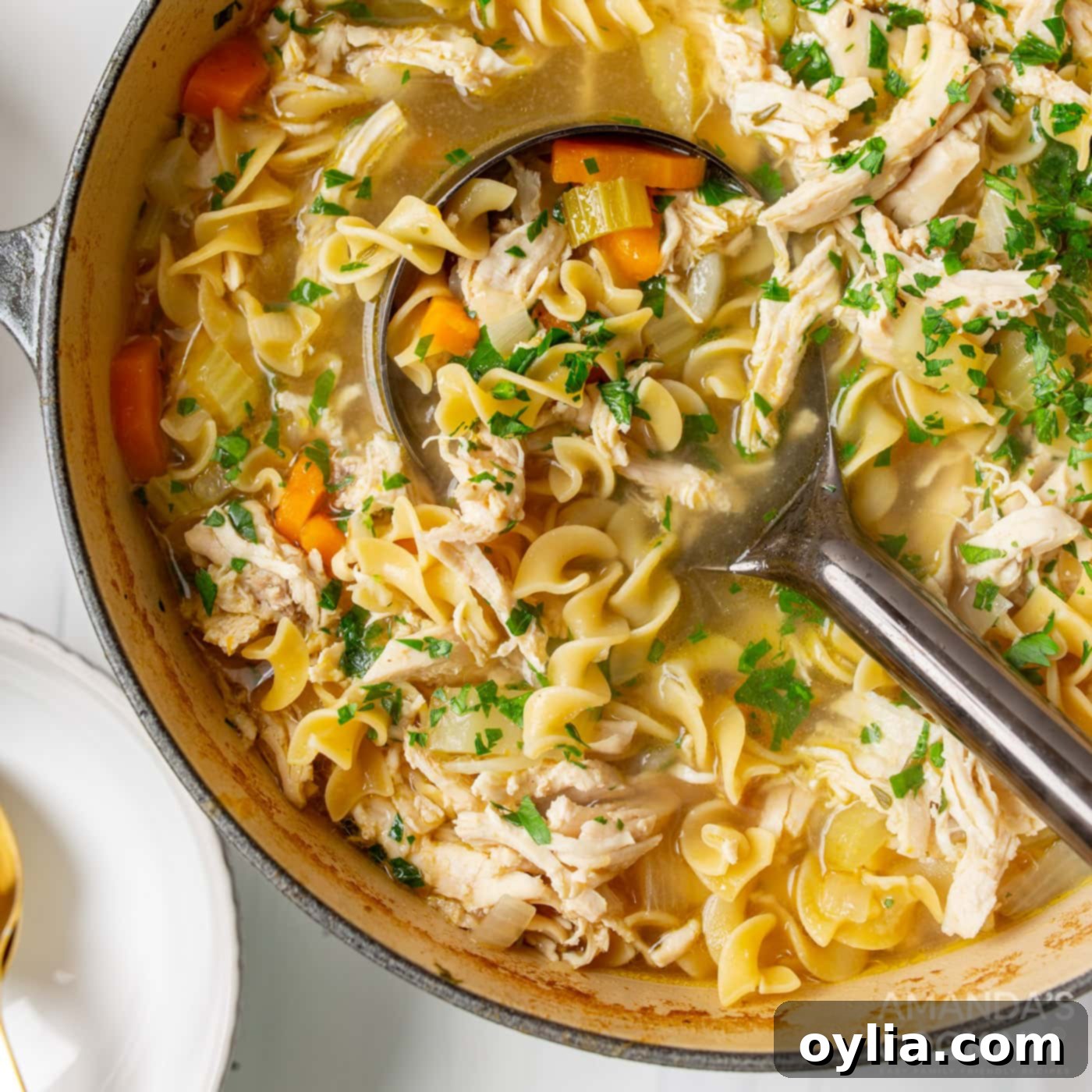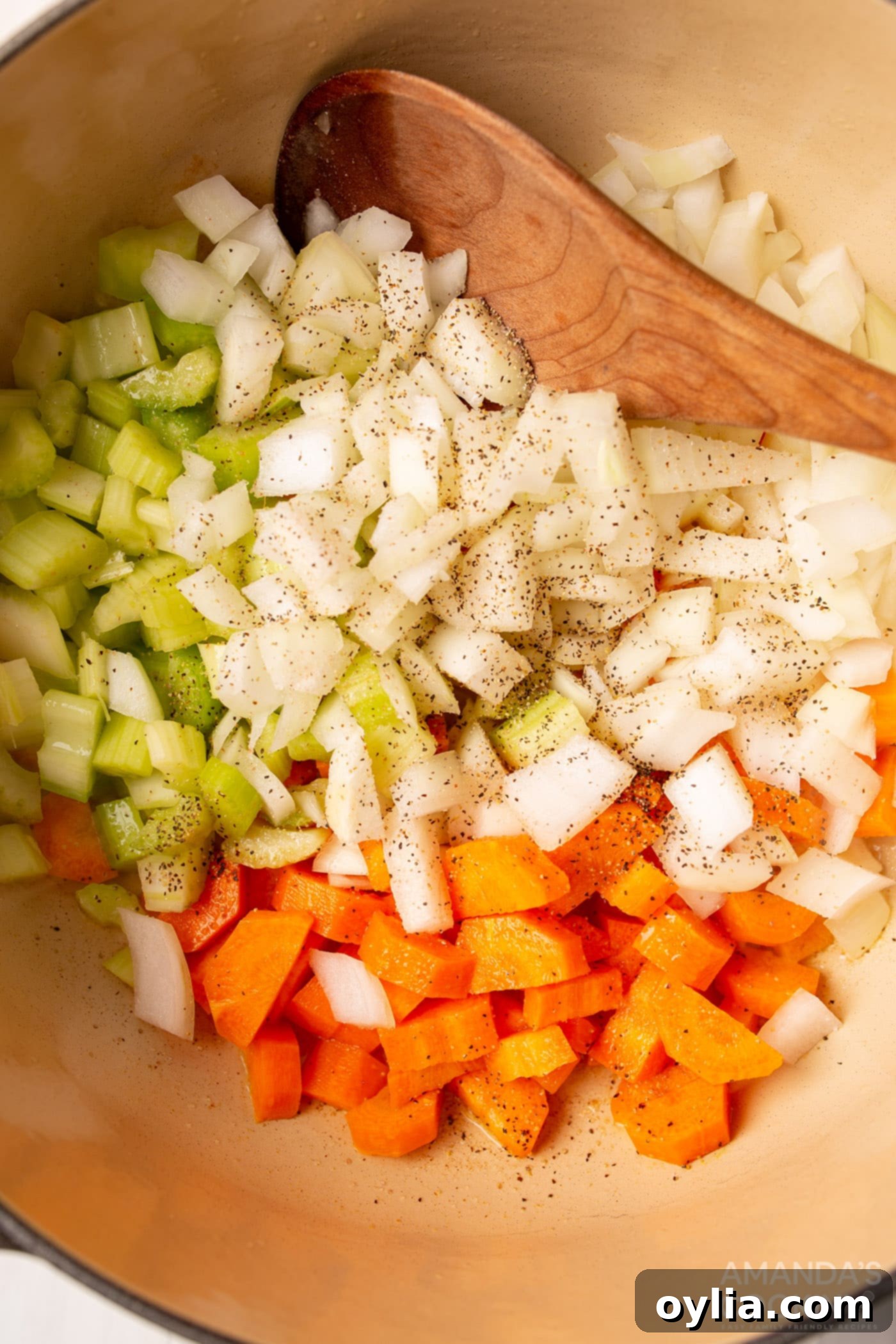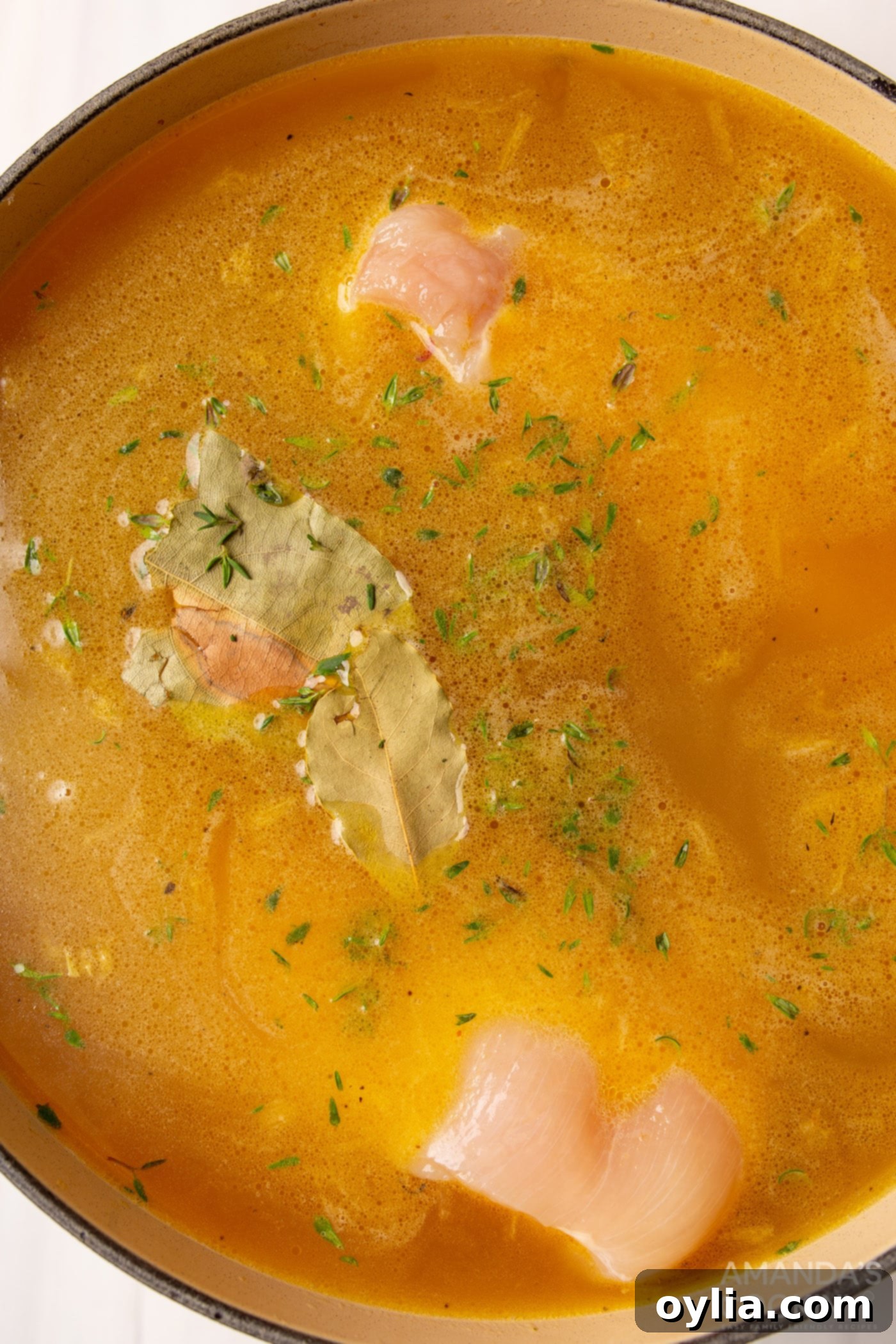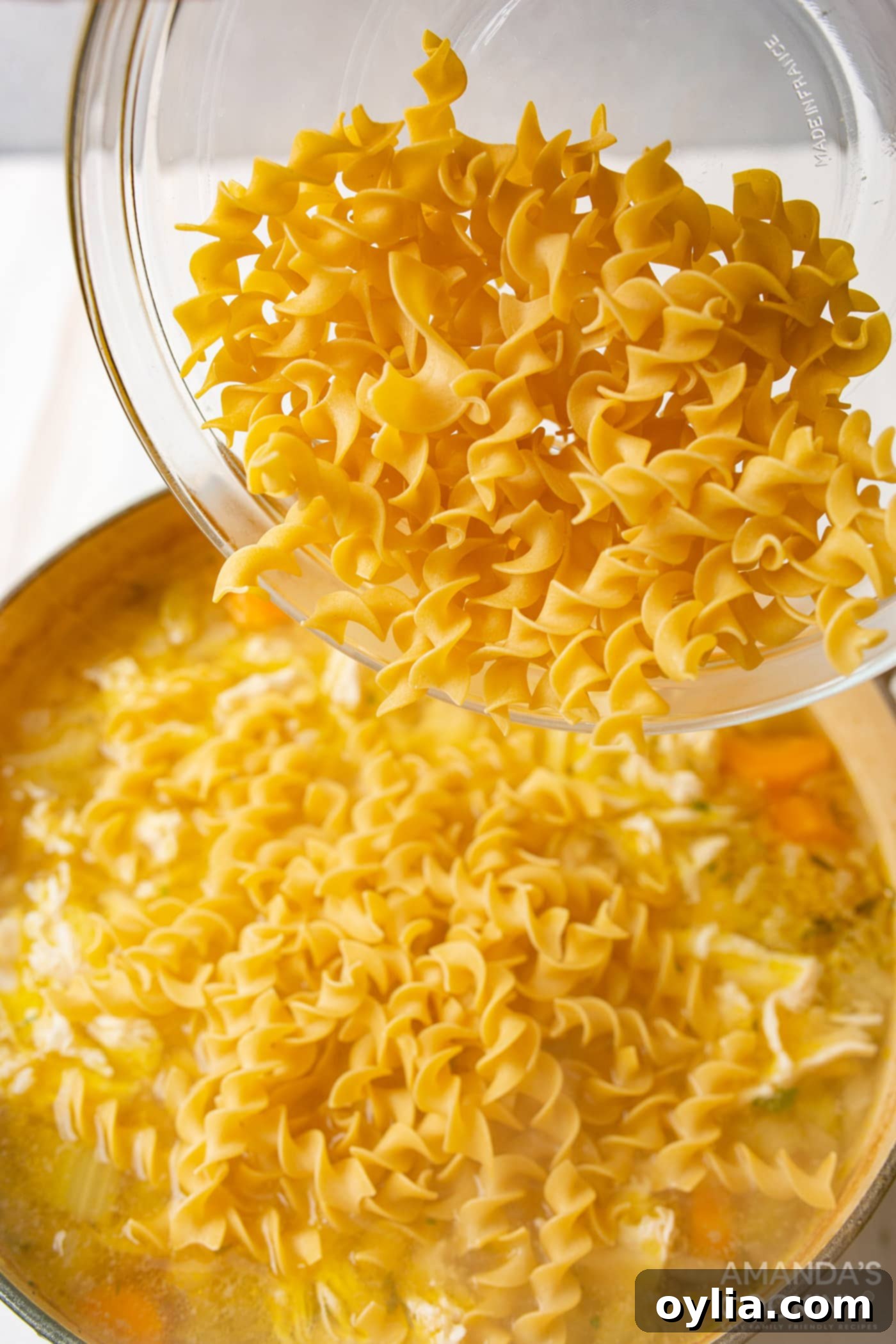The Ultimate Comfort Food: Easy Homemade Chicken Noodle Soup Recipe
This easy chicken noodle soup recipe is more than just a meal; it’s a warm hug in a bowl, a timeless remedy, and a taste of home. Perfect for chasing away the chill on a brisk autumn or winter day, or providing soothing comfort when you’re feeling under the weather, this homestyle classic promises to nourish both body and soul. Our simple-to-follow recipe brings together wholesome ingredients and rich flavors, ensuring a hearty and satisfying experience every time you ladle it into a bowl.
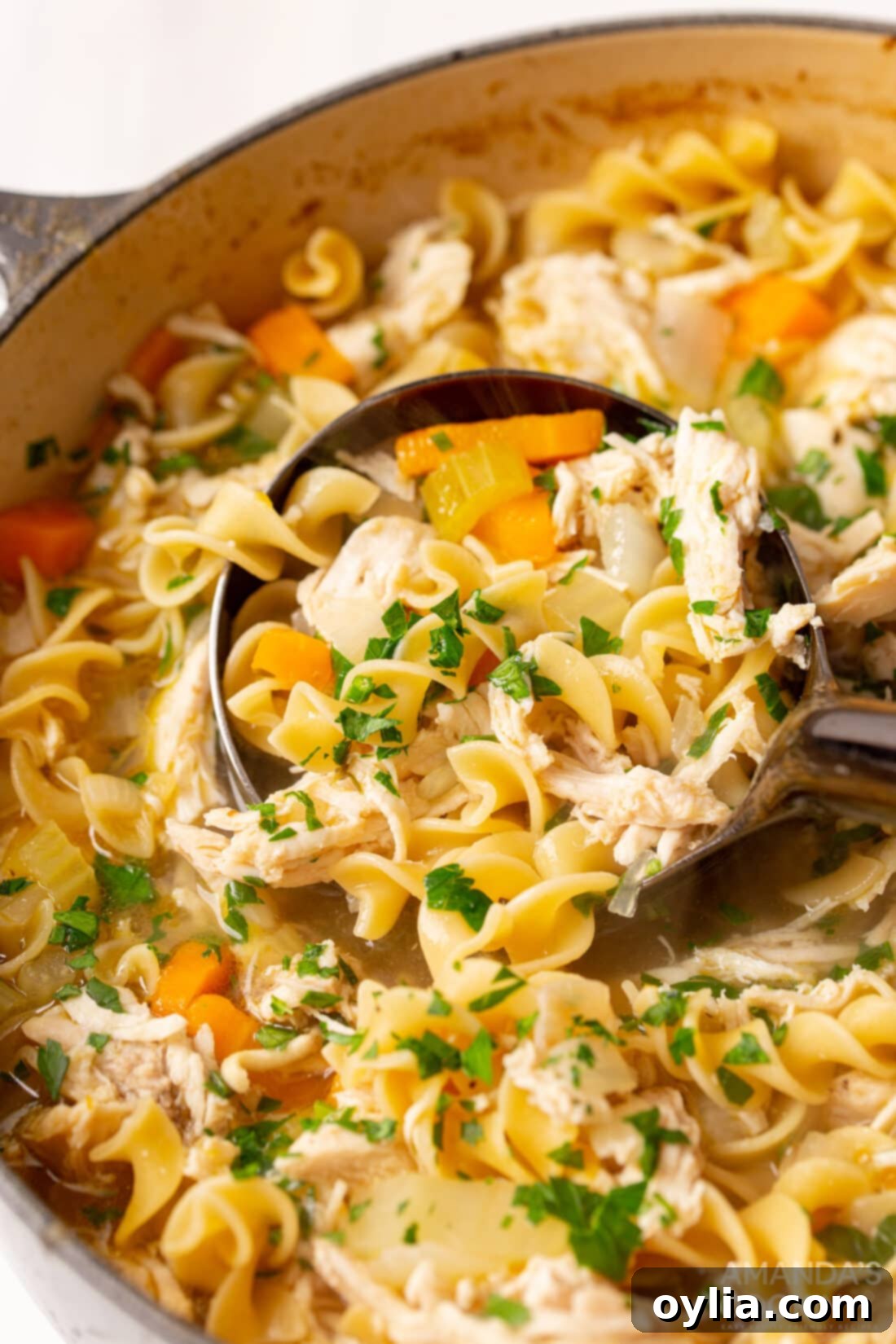
Why This Homemade Chicken Noodle Soup Recipe Works
There’s a reason why chicken noodle soup is a beloved staple in homes worldwide, and our recipe elevates it to perfection. Crafted with the freshest ingredients, this classic chicken noodle soup boasts an incredible depth of flavor that is simmered slowly to achieve a rich, aromatic broth. The vibrant combination of tender carrots, sweet onion, crisp celery, succulent shredded chicken, and hearty egg noodles, all infused with a generous blend of aromatic herbs and seasonings, creates a colorful, flavorful, and utterly delicious masterpiece.
Beyond its incredible taste, chicken noodle soup holds a special place in our hearts as a traditional cure-all for the common cold and a quintessential cozy meal for chilly days. The warm, steamy broth, packed with nourishing vegetables and lean protein, is known to help soothe a sore throat and hydrate the body. It’s not just a physical comfort; there’s a profound psychological comfort in a bowl of this classic soup. We often turn to a big batch of this easy chicken noodle soup or a hearty homemade chili whenever we crave a comforting meal that truly sticks to your bones and warms you from the inside out. This recipe ensures maximum flavor with minimal fuss, making it ideal for busy weeknights or lazy weekends.
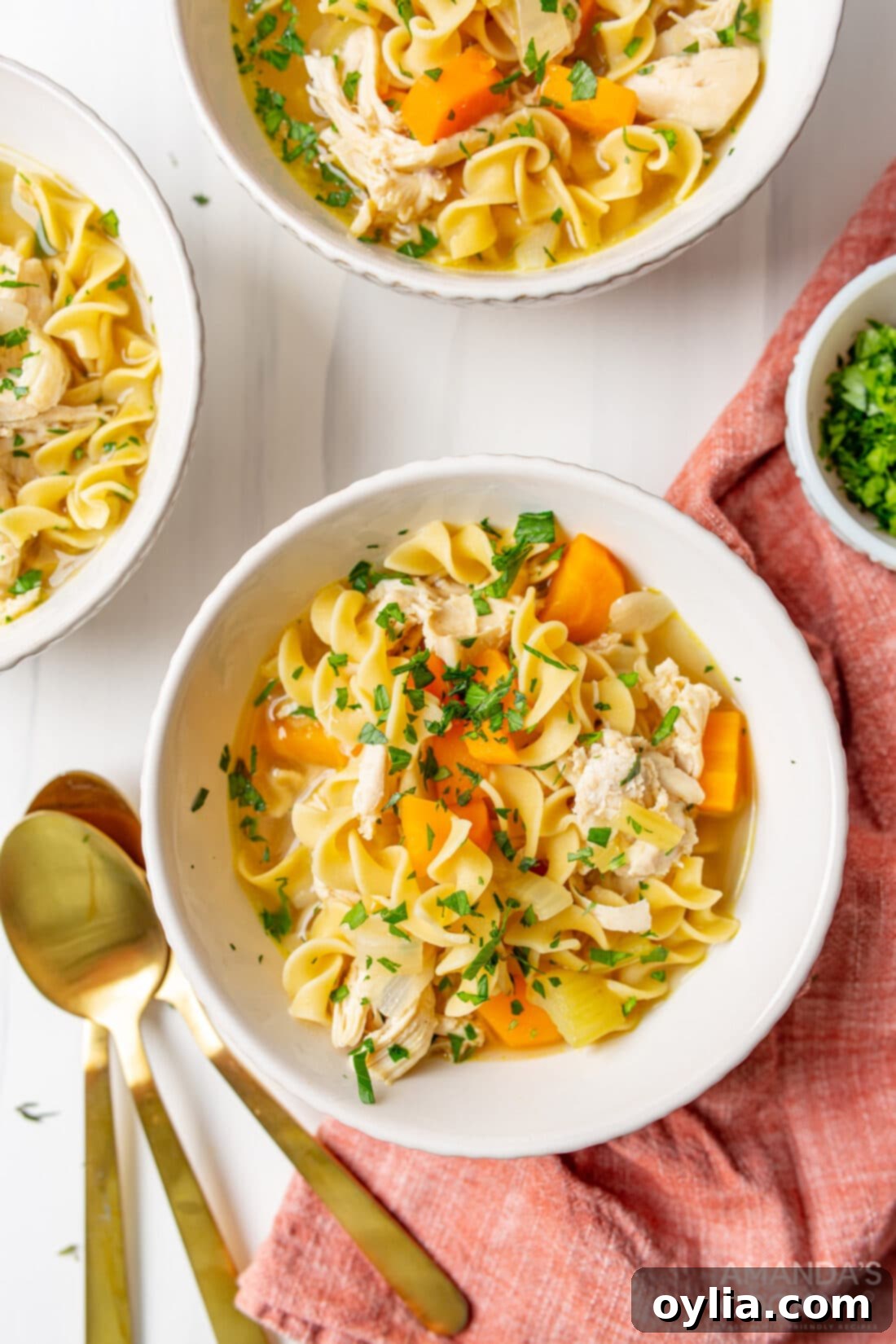
Ingredients You Will Need for This Easy Chicken Noodle Soup
To create this soul-warming, simple chicken noodle soup, you’ll need a selection of fresh and pantry-friendly ingredients. From the foundational vegetables to the tender chicken and classic egg noodles, each component plays a vital role in building the authentic flavor profile of this beloved dish. For precise measurements, a detailed list of ingredients, and comprehensive instructions, please refer to the printable version of the recipe card located at the end of this post.
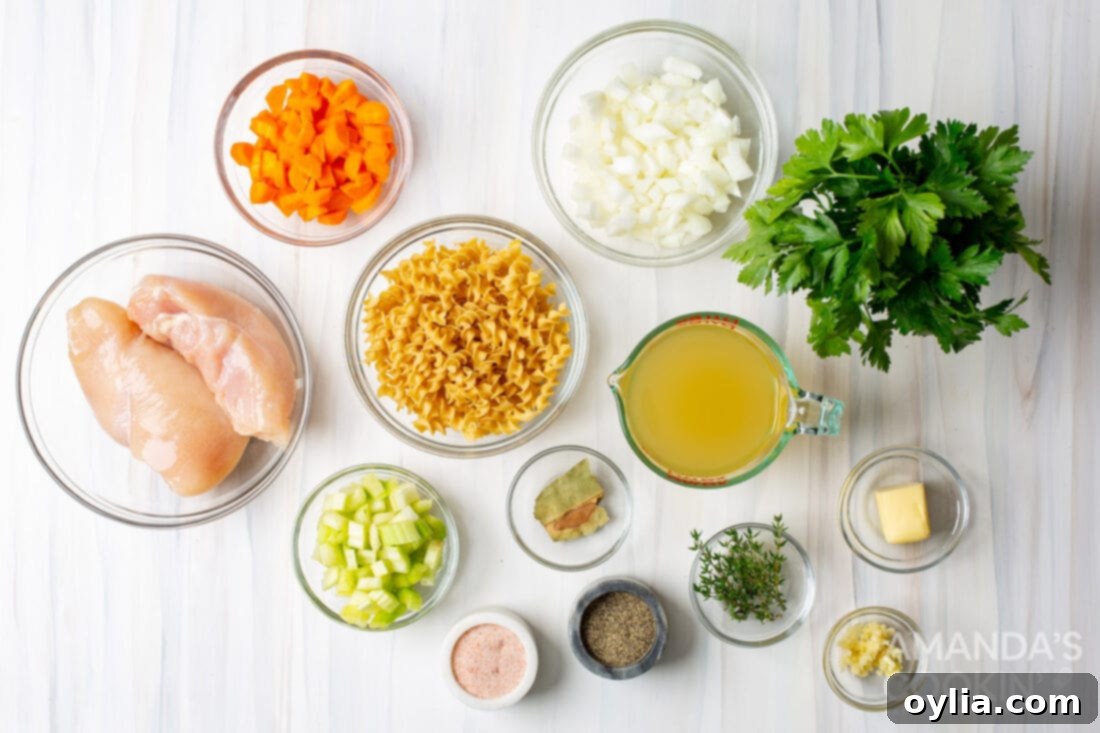
Ingredient Information and Smart Substitution Suggestions
Understanding your ingredients and knowing when and how to make substitutions can greatly enhance your cooking experience and adaptability in the kitchen. Here’s a deeper dive into the key components of our homemade chicken noodle soup:
CHICKEN – This classic chicken noodle soup recipe primarily uses boneless, skinless chicken breasts. This choice is ideal because they cook quickly and are easy to shred, blending seamlessly into the soup without any fuss. However, you have options! If you prefer a richer broth, bone-in, skinless chicken breasts or even chicken thighs can be used. Just be aware that bone-in cuts will require a slightly longer simmering time to ensure they are fully cooked and to impart their full flavor into the broth. An excellent time-saving alternative is shredded rotisserie chicken. If using pre-cooked chicken, add it towards the end of the cooking process, after the vegetables have softened and the broth has simmered, to prevent it from becoming tough. While convenient, remember that cooking raw chicken in the broth significantly contributes to the depth of flavor in the final soup, something a pre-cooked chicken might not achieve as intensely.
NOODLES – The heart of “chicken noodle soup” lies, of course, in its noodles! We recommend wide egg noodles for their traditional texture and ability to absorb the savory broth beautifully. They are hearty and comforting. However, feel free to get creative with your noodle choice. Thinner egg noodles, ditalini, orzo, or even alphabet pasta (a fun choice for kids!) can all work wonderfully. If you’re looking for a gluten-free option, ensure you choose a pasta variety that holds up well in soup and consider cooking it separately and adding it to individual bowls to prevent it from getting mushy if you plan on having leftovers. Always check the package instructions for your chosen noodle type, as cooking times can vary considerably.
BROTH – A good quality chicken broth is the backbone of any delicious chicken noodle soup. For the best flavor, a low-sodium chicken broth allows you to control the seasoning precisely. If you have homemade chicken stock on hand, that’s even better, as it adds unparalleled depth. If using bouillon cubes or concentrate, dilute according to package directions, remembering that these can be quite salty, so adjust seasoning later.
VEGETABLES – Our recipe calls for the classic mirepoix of onion, carrots, and celery, which forms the aromatic foundation of the soup. Dicing them to a consistent, medium-to-small size ensures even cooking. Feel free to add other vegetables for extra nutrients and flavor. A cup of frozen peas or corn can be stirred in during the last few minutes of cooking, and fresh spinach or kale can be wilted into the hot soup just before serving for a burst of green color and added goodness.
HERBS and SEASONINGS – Bay leaves and fresh thyme are essential for imparting that classic, earthy aroma and flavor. If fresh thyme isn’t available, you can substitute with dried thyme, using about half the amount (e.g., 1/2 tsp dried for 1 Tbsp fresh). Fresh parsley, added at the very end, brightens the soup and adds a touch of freshness. Don’t forget salt and freshly cracked black pepper – they are crucial for bringing all the flavors into balance.
How to Make Homemade Chicken Noodle Soup from Scratch
These step-by-step photos and detailed instructions are here to guide you through making this incredibly satisfying soup. You can Jump to Recipe to find the printable version of this recipe, complete with precise measurements and full instructions at the bottom of this page.
- In a sturdy 5 quart Dutch oven or a large heavy-bottomed pot over medium heat, melt the butter until it shimmers. Add the diced onion, carrots, and celery. These “aromatics” are the flavor base of your soup. Sauté them for about 5 minutes, stirring occasionally, until they begin to soften and become fragrant but don’t brown. This process, known as “sweating,” helps to release their natural sweetness and build a foundational flavor. Season lightly with salt and pepper at this stage. Then, add the minced garlic and cook for just 30 seconds more, stirring constantly, until it’s fragrant. Be careful not to burn the garlic, as it can turn bitter quickly.

- Carefully pour in the chicken stock. Add the bay leaves and fresh thyme. These herbs will infuse the broth with deep, aromatic flavors as it simmers. Give everything a good stir to combine all the ingredients.
- Increase the heat to bring the soup to a gentle boil. Once boiling, carefully add the raw boneless, skinless chicken breasts to the pot, ensuring they are fully submerged in the liquid. Reduce the heat to a gentle simmer, cover the pot, and let the chicken poach for approximately 30 minutes. Poaching the chicken directly in the broth not only cooks it perfectly but also adds a fantastic savory depth to the soup, making it truly homemade.

- Once the chicken is cooked through (you can check with a meat thermometer; it should read 165°F/74°C), carefully remove it from the pot and set it aside to cool slightly. While the chicken cools, remember to remove and discard the bay leaves from the soup – their work is done! Once the chicken is cool enough to handle, use two forks to shred it into bite-sized pieces. Return the shredded chicken to the pot along with the uncooked egg noodles. Stir well to ensure the noodles are submerged. Cover the pot again and continue to simmer until the noodles are tender yet still have a slight bite (al dente), which usually takes about 8 minutes.

- Before serving, stir in the finely chopped fresh parsley. This adds a beautiful burst of color and a fresh, herbaceous note that brightens the entire soup. Taste the soup and adjust seasonings (salt and pepper) as needed. Serve immediately, piping hot, and enjoy your delicious, homemade chicken noodle soup!
Frequently Asked Questions & Expert Tips for Perfect Chicken Noodle Soup
Here are some common questions and invaluable tips to help you master this comforting chicken noodle soup recipe:
Yes, you absolutely can freeze chicken noodle soup, making it a fantastic meal prep option for busy weeks. However, we highly recommend freezing it without the noodles. Pasta tends to absorb a lot of liquid and can become quite soggy and mushy once thawed and reheated, compromising the texture of your soup. For the best results, freeze all the other ingredients (broth, chicken, vegetables) together in an airtight container or a large freezer-safe Ziploc bag. It can be stored in the freezer for up to 3 months. When you’re ready to enjoy it, thaw the soup in the refrigerator overnight, then reheat it gently on the stovetop. Cook fresh noodles separately according to package directions and add them to the individual bowls of hot soup just before serving. This ensures perfectly textured noodles every time!
Absolutely! Making chicken noodle soup in the crockpot is a convenient way to achieve rich flavor with minimal effort. To adapt this recipe for your slow cooker, combine the raw chicken breasts along with all of the other ingredients (except the noodles and fresh parsley) in your slow cooker. Cover and cook on the low setting for 6-8 hours, or on high for 3-4 hours, until the chicken is tender and cooked through. Once cooked, carefully remove the chicken and any fresh bay leaves. Shred the chicken using two forks and return it to the crockpot. At this point, add the uncooked egg noodles. Cover again and cook for an additional 20-30 minutes, or until the noodles are al dente. Stir in fresh parsley just before serving for a vibrant finish. The slow cooker method is perfect for developing deep flavors with very little hands-on time.
This recipe produces a lovely, flavorful broth with a natural consistency. However, if you prefer a thicker soup, you have a couple of options. You can create a simple slurry by whisking together 1-2 tablespoons of cornstarch with an equal amount of cold water until smooth. Stir this mixture into the simmering soup towards the end of cooking and let it simmer for another 2-3 minutes, until the soup thickens to your desired consistency. Alternatively, you could start with a roux by whisking 1-2 tablespoons of flour into the melted butter before adding the vegetables in step 1, cooking it for about a minute to remove the raw flour taste.
A few simple tricks can elevate your soup even further. Towards the end of cooking, a squeeze of fresh lemon juice can brighten all the flavors. A dash of your favorite hot sauce or a pinch of red pepper flakes can add a subtle kick. For an even richer broth, consider roasting your chicken bones (if using bone-in chicken) before simmering them, or adding a parmesan rind to the broth while it simmers, removing it before serving. Always taste and adjust seasonings, especially salt and pepper, right before serving, as flavors can mellow during simmering.
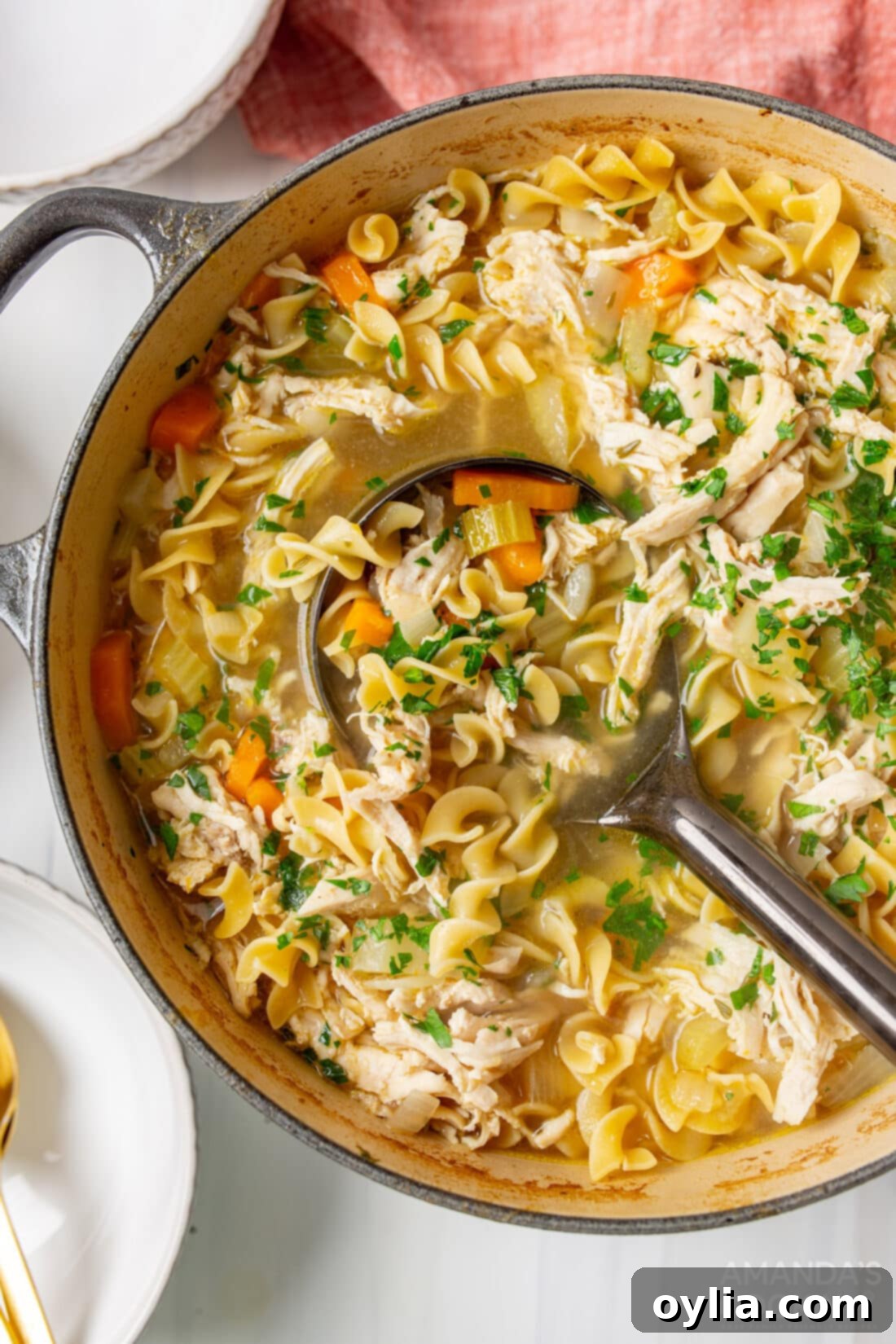
Serving Suggestions for Your Perfect Chicken Noodle Soup
While a bowl of chicken noodle soup is a complete and satisfying meal all on its own, its comforting nature makes it a versatile dish that pairs wonderfully with a variety of accompaniments. Enjoy it steaming hot straight from the stovetop, either for a nourishing lunch or a hearty dinner. Here are some serving ideas to enhance your experience:
- Classic Crackers: A handful of saltine crackers or a sprinkle of crispy oyster crackers are traditional and add a delightful crunch.
- Crusty Bread: Serve with slices of warm, crusty bread or a baguette for dipping into the flavorful broth. Garlic bread or cheese toast also make excellent companions.
- Grilled Cheese: Few pairings are as iconic and comforting as a bowl of chicken noodle soup alongside a gooey grilled cheese sandwich.
- Light Salad: For a more balanced meal, a simple side salad with a light vinaigrette offers a refreshing contrast to the richness of the soup.
- Sandwiches or Paninis: Beyond grilled cheese, consider serving smaller portions of the soup alongside other favorite sandwiches or hot paninis for a more substantial meal.
- Cornbread: A warm slice of cornbread adds a rustic, sweet, and savory element that complements the soup beautifully.
No matter how you choose to serve it, this homemade chicken noodle soup is sure to bring warmth and joy to your table.
More Delicious Soup Recipes to Explore
If you love the comforting warmth of a hearty soup, you’re in luck! We have a wide array of delicious soup recipes that are perfect for any occasion, from quick weeknight meals to cozy weekend dinners. Expand your culinary repertoire with these other tried-and-true favorites:
- Hearty Taco Soup
- Classic Ham and Bean Soup
- Velvety Cream of Asparagus Soup
- Flavorful Chicken Tortilla Soup
- Easy One Pot Vegetable Rice Soup
- Satisfying Italian Sausage Tomato Orzo Soup
- Rich Homemade Cream of Chicken Soup
- Comforting Chicken Stuffing Casserole (While not a soup, this casserole offers similar comforting flavors!)
Each recipe is crafted with care to bring deliciousness to your kitchen!
I absolutely adore cooking and baking, and my greatest joy is sharing my kitchen adventures and recipes with all of you! It can be challenging to remember to check back every day for new delights, which is why I offer a convenient newsletter delivering fresh recipes straight to your inbox every time a new one is posted. Simply subscribe today and start receiving your free daily recipes to inspire your next meal!

Chicken Noodle Soup
IMPORTANT – There are often Frequently Asked Questions within the blog post that you may find helpful. Simply scroll back up to read them!
Print It
Pin It
Rate It
Save It
Saved!
Ingredients
- 2 Tbsp butter
- 1 yellow onion diced, medium to small, about 3/4 cup
- 3 carrots halved into crescents, about 1/2 to 3/4 cup
- ½ cup celery diced
- ½ tsp salt
- ¼ tsp black pepper
- 2 tsp garlic minced
- 6 cups chicken broth 6-8 cups, can also use 1/2 water
- 2 bay leaves
- 1 Tbsp fresh thyme leaves or 1/2 tsp dried
- 2 lbs boneless skinless chicken breasts
- 6 oz wide egg noodles 6-8 oz
- ¼ cup fresh parsley chopped
Things You’ll Need
-
5 qt Dutch oven
Before You Begin
- This recipe calls for boneless skinless chicken breasts. You may substitute for bone-in skinless chicken breasts if you’d like, but you will likely need to simmer the chicken for longer to let it cook through.
- For optimal flavor, always use fresh, high-quality ingredients.
- Read through the entire recipe before you begin to familiarize yourself with the steps.
Instructions
-
In a 5 quart dutch oven over medium heat, melt the butter. Add the onion, carrots, and celery and sweat for 5 minutes. Season with salt and pepper. Add the garlic and cook for 30 seconds.
-
Pour in the chicken stock along with the bay leaves and thyme.
-
Bring to a boil and add the raw chicken breasts to poach, fully submerging them. Lower to a simmer for about 30 minutes.
-
Remove chicken and shred. Remove bay leaves and discard. Return chicken to pot with uncooked egg noodles. Cover and simmer until noodles are cooked, about 8 minutes.
-
Add finely chopped parsley and serve.
Nutrition
The recipes on this blog are tested with a conventional gas oven and gas stovetop. It’s important to note that some ovens, especially as they age, can cook and bake inconsistently. Using an inexpensive oven thermometer can assure you that your oven is truly heating to the proper temperature. If you use a toaster oven or countertop oven, please keep in mind that they may not distribute heat the same as a conventional full sized oven and you may need to adjust your cooking/baking times. In the case of recipes made with a pressure cooker, air fryer, slow cooker, or other appliance, a link to the appliances we use is listed within each respective recipe. For baking recipes where measurements are given by weight, please note that results may not be the same if cups are used instead, and we can’t guarantee success with that method.
